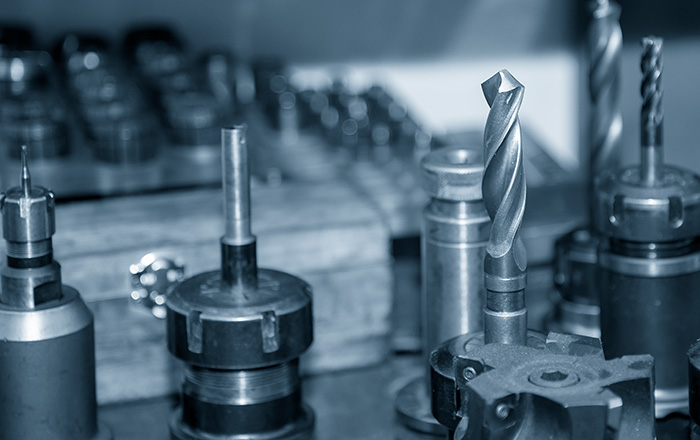Types of CNC Machining Tools
CNC machining tools are essential elements of the CNC machining process, as they are responsible for a variety of cutting and other machining operations. Different types of CNC machining tools have different properties which make them suitable for different functionalities and contribute to reducing the manual input required by machine operators. This helps to minimize operator fatigue and errors – offering a more efficient and reliable manufacturing process.
CNC machining tools are power-operated machines that can be used to process materials into desired shapes and sizes. These types of tools are commonly divided into turning, milling, drilling, and grinding. Cutting machines are the most widely used CNC machine tools as they allow for precision cutting and shaping of materials. This guide will outline the different uses and functions of each type of machine tool.
- CNC Turning Tools
- CNC Cutting Tools (CNC Milling Tools)
- Drilling Tools
- Grinding Tools
- CNC Turning Tools

CNC turning is a machining process used to shape metal or other materials through the use of a turning tool in a lathe. The rotational speed capabilities of CNC turning machines make them highly accurate and capable of creating complex shapes. Common examples of CNC turning tools include lathes, drills, reamers, parting tools, threading tools, and counterbores. By combining various types of cutting tools with different speeds and feed rates, CNC turnings can create a variety of shapes with accuracy and high-precision.
Boring Tools
When looking for a precise cutting tool for CNC turning applications, boring tools are an excellent option. These tools provide precise and accurate enlargement of holes that have already been drilled or cast into the workpiece, allowing for high levels of accuracy during the machining process.
Chamfering Tools
One particular tool that is often employed in machining projects is the chamfering tool. This tool can be used to create angled surfaces, or “chamfers,” on a workpiece, as well as deburr sharp edges, and provide beveling capabilities.
Parting Tools
A CNC machining parting tool, has a blade-like edge which is used to cut materials away from the workpiece or to cut the finished part from the rest of the workpiece. Parting tools are often necessary to complete a CNC machining process.
Knurling Tools
The knurling tools, are used to create patterns on the surface of workpieces. These patterns, which can include diagonal, straight, or diamond styles, provide better grip and improved functionality of the finished product.
- CNC Cutting Tools (CNC Milling Tools)
CNC cutting tool is one of the main tools used in the CNC machining industry. It utilizes various types of CNC cutting tools, which are known as CNC milling cutters or CNC cutters. This procedure is different from cutting because it works with a milling machine that uses these cutters to move around and remove material from different parts of a fixed workpiece to create accurate shapes and designs. Different types of CNC milling tools can be used in combination with each other to achieve the desired results.
End Mill
CNC cutting tools, which are often referred to as end mills, are immensely important in the CNC industry. They are similar to drill bits, sharing many of the same features, but have far more versatility because they can be used for milling procedures without any pre-drilled spots. Three types of end mills exist; bull nose, ball nose and flat end mills.
Ball End Mill
Ball end mills, are employed in a variety of milling operations to create complex contours and profiles. Also known as “ball nose” or full-radius end mills, these tools have a single constant radius at the end of the cutting tool with no sharp corners or straight edges. Their unique shape makes them suitable for achieving 3D part contours with large corner radii and grooves that feature a full radius. Ball end mills are often used for finishing and semi-finishing operations in mold making, tool & die, and other specialist applications.
Chamfer End Mill
CNC machining tool such as Chamfer Mills possess multi-functional capabilities and are widely used by machinists. Mostly due to the fact that most machined parts require at least one chamfer operation. The tool is designed to generally remove sharp edges from a workpiece which could result from certain machining operations and leave behind a smooth angled surface or chamfer. Additionally, Chamfer Mills can also be implemented to create a full bevel on the edge of a part, breaking off sharp corners, countersinking holes, or preparing material pieces for welding operations.
Dovetail Cutter
CNC dovetail cutters are designed to cut angled or trapezoidal grooves, also known as dovetails, into a workpiece. These specialized tools are used in industries ranging from woodworking to metal manufacturing. They can be used for cutting male and female parts of dovetail joints, trimming bevels and undercuts, deburring components, and machining external features in a fast and secure manner for setups involving 5-axis operations.
Slab Mill
slab mills are designed to produce flat surfaces on your workpieces. These tools can be used for robust operations and must be oriented with the surface of the workpiece parallel to the CNC mill table in order to be effective.
Face Mill
CNC machining has many different tools at its disposal to complete its tasks. Face mills are one such type of tool, with flat faces containing interchangeable carbide-tipped cutting edges. This makes them ideal for achieving flat sections on workpieces, as they can only cut horizontally. What makes face mills so beneficial is their ability to swap out cutting edges, allowing them to be used for a longer period of time.
Rounding End Mill
A rounding end mill is a type of CNC machining tool used to create curved edges at the top of a wall, panel, or recess. This tool is perfect for creating rounded corners and other decorations on materials like wood, aluminum, steel, and plastic. With this versatile tool, you can easily produce customized or shaped features with precise accuracy.
- Drilling Tools
CNC drill bits, are used by machinists to create holes in workpieces. They employ either twist drills or CNC mills and use their flutes and tapered cutting points to do so. Examples of these tools include cutting taps and dies, reamers, countersinks and counterbores, all of which are used in different processes depending on the desired size and shape of the hole.
Center Drills
In CNC machining, center drills are important tooling components that enable machinists to drill accurate holes onto the workpiece surface. Center drills enable machinists to create a starting point where larger drill bits can be used for drilling deeper and larger holes.
Ejector Drills
CNC machining tool ejector drills are specifically designed for creating larger and deeper holes. These tools are mostly used after center drills to achieve their intended purpose. Ejector drills come in various sizes and designs, making them suitable for a variety of materials and applications.
Twist Drills
Twist drills are commonly used by machinists to create holes in parts and materials. This type of tool does not need to be held to specific parameters or specifications, instead making it well suited for basic drilling tasks.
- Grinding Tools
The most commonly used machining tool is the cutting tool, which uses a hardened cutting edge to remove material from the workpiece by either chipping or shaving it away. In addition to traditional cutting tools, CNC machining can also utilize grinding tools for finishing operations. Grinding tools typically come in the form of an abrasive wheel which is used to clean up and refine a surface.
